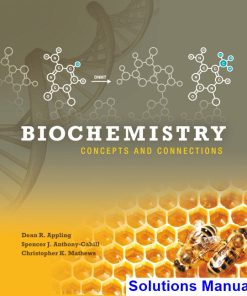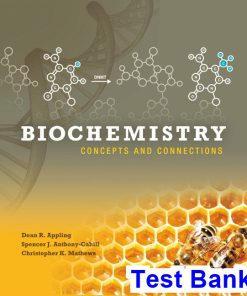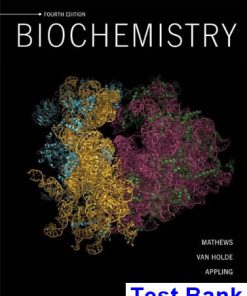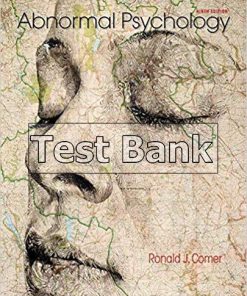Biochemistry 1st Edition Miesfeld Test Bank
You may also like
-
$26.50
$50.00 -
$26.50
$50.00 -
$26.50
$50.00 -
$26.50
$50.00
Biochemistry 1st Edition Miesfeld Test Bank
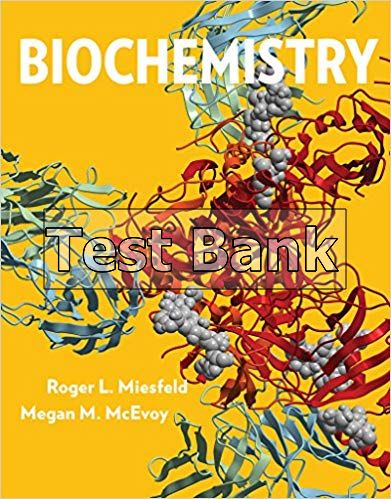
Product details:
- ISBN-10 : 0393615081
- ISBN-13 : 978-0393615081
- Author: Roger Miesfeld
Biochemistry promotes understanding of biochemical concepts through highly readable chapters that consistently integrate stunning graphics with text. Its distinctive table of contents highlights how biochemical processes work, and applications to everyday biochemistry ensure that students develop a complete understanding of why biochemistry matters.
Table contents:
1. Biochemistry: An Introduction
Life: It Is a Mystery!
1.1 What is Life?
1.2 Biomolecules
Functional Groups of Organic Biomolecules
Major Classes of Small Biomolecules
1.3 Is the Living Cell a Chemical Factory?
Biochemical Reactions
Energy
Overview of Metabolism
Biological Order
1.4 Systems Biology
Emergence
Robustness
Modularity
Biochemistry in the Lab: An Introduction
2. Living Cells
Our Bodies, Our Selves
2.1 Basic Themes
Water Biological Membranes
Self-Assembly
Molecular Machines
Macromolecular Crowding
Signal Transduction
2.2 Structure of Prokaryotic Cells
Cell Wall
Plasma Membrane
Cytoplasm
Pili and Flagella
2.3 Structure of Eukaryotic Cells
Plasma Membrane
Endoplasmic Reticulum
Golgi Apparatus
Nucleus
Vesicular Organelles
Mitochondria
Peroxisomes
Plastids
Cytoskeleton
Ribosomes
Biochemistry in Perspective: Primary Cilia and Human Disease
Biochemistry in the Lab: Cell Technology
Available Online:
Biochemistry in Perspective: Organelles and Human Disease
3. Water: The Matrix of Life
Water, Water Everywhere
3.1 Molecular Structure of Water
3.2 Noncovalent Bonding
Ionic Interactions
Hydrogen Bonds
Van der Waals Forces
3.3 Thermal Properties of Water
3.4 Solvent Properties of Water
Hydrophillic Molecules, Cell Water Structuring, and Sol-Gel Transitions
Hydrophobic Molecules and the Hydrophobic Effect
Amphipathic Molecules
Osmotic Pressure
3.5 Ionization of Water
Acids, Bases and pH
Buffers
Physiological Buffers
Biochemistry in Perspective: Cell Volume Regulation and Metabolism
Available Online:
Biochemistry in Perspective: Water, Abiotic Stress, and Compatible Solutes
Biochemistry in the Lab: Dialysis
4. Energy
Energy and Life’s Deep Dark Secrets
4.1 Thermodynamics
First Law of Thermodynamics
Second Law of Thermodynamics
4.2 Free Energy
Standard Free Energy Changes
Coupled Reactions
The Hydrophobic Effect Revisited
4.3 The Role of ATP
Biochemistry in Perspective: Nonequilibrium Thermodynamics and the Evolution of Life
Available Online:
Biochemistry in Perspective: The Extremophiles: Organisms That Make a Living in Hostile Environments
5. Amino Acids, Peptides, and Proteins
Spider Silk: A Biosteel Protein
5.1 Amino Acids
Amino Acid Classes
Biologically Active Amino Acids
Modified Amino Acids in Proteins
Amino Acid Stereoisomers
Titration of Amino Acids
Amino Acid Reactions
5.2 Peptides
5.3 Proteins
Protein Structure
The Folding Problem
Fibrous Proteins
Globular Proteins
5.4 Molecular Machines
Motor Proteins
Biochemistry in Perspective: Spider Silk and Biomimetics
Biochemistry in the Lab: Protein Technology
Available Online:
Biochemistry in Perspective: Myosin: A Molecular Machine
Biochemistry in Perspective: Protein Folding and Human Disease
Biochemistry in Perspective: Protein Poisons
Biochemistry in the Lab: Protein Sequence Analysis: The Edman Degradation
6. Enzymes
Humans and Enzymes: A Brief History
6.1 Properties of Enzymes
6.2 Classification of Enzymes
6.3 Enzyme Kinetics
Michaelis-Menten Kinetics
Lineweaver-Burk Plots
Multisubstrate Reactions
Enzyme Inhibition
Enzyme Kinetics, Metabolism and Macromolecular Crowding
6.4 Catalysis
Organic Reactions and the Transition State
The Roles of Amino Acids in Enzyme Catalysis
The Role of Cofactors in Enzyme Catalysis
Effects of Temperature and pH on Enzyme-Catalyzed Reactions
Detailed Mechanisms of Enzyme Catalysis
6.5 Enzyme Regulation
Genetic Control
Covalent Modification
Allosteric Regulation
Compartmentation
Biochemistry in Perspective: Alcohol Dehydrogenase: A Tale of Two Organisms
Available Online:
Biochemistry in Perspective: Quantum Tunneling and Catalysis
Biochemistry in Perspective: Enzymes and Clinical Medicine
7. Carbohydrates
Sweet and Bitter Tastes: The Role of Sugar Molecules
7.1 Monosaccharides
Monosaccharide Stereoisomers
Cyclic Structure of Monosaccharides
Reactions of Monosaccharides
Important Monosaccharides
Monosaccharide Derivatives
7.2 Disaccharides
7.3 Polysaccharides
Homoglycans
Heteroglycans
7.4 Glycoconjugates
Proteoglycans
Glycoproteins
7.5 The Sugar Code
Lectins: Translators of the Sugar Code
Biochemistry in the Lab: Glycomics
Available Online:
Biochemistry in Perspective: Sweet Medicine
Biochemistry in Perspective: Conversion of Fischer Structure onto Haworth Structure
8. Carbohydrate Metabolism
Metabolism and Jet Engines
8.1 Glycolysis
The Reactions of the Glycolytic Pathway
The Fates of Pyruvate
The Energetics of Glycolysis
Regulation of Glycolysis
8.2 Gluconeogenesis
Gluconeogenesis Reactions
Gluconeogenesis Substrates
Gluconeogenesis Regulation
8.3 The Pentose Phosphate Pathway
8.4 Metabolism of Other Important Sugars
Fructose Metabolism
8.5 Glycogen Metabolism
Glycogenesis
Glycogenolysis
Regulation of Glycogen Metabolism
Biochemistry in Perspective: Saccharomyces cerevisiae and the Crabtree Effect
Biochemistry in Perspective: Turbo Design Can Be Dangerous
Available Online:
Biochemistry in Perspective: Fermentation: An Ancient Heritage
9. Aerobic Metabolism I: The Citric Acid Cycle
Oxygen and Evolution: Chance and Necessity
9.1 Oxidation-Reduction Reactions
Redox Coenzymes
Aerobic Metabolism
9.2 Citric Acid Cycle
Conversion of Pyruvate to Acetyl-CoA
Reactions of the Citric Acid Cycle
Fate of Carbon Atoms in the Citric Acid Cycle
The Amphibolic Citric Acid Cycle
Citric Acid Cycle Regulation
The Citric Acid Cycle and Human Disease
The Glyoxylate Cycle
Biochemistry in Perspective: The Evolutionary History of the Citric Acid Cycle
Available Online:
Hans Krebs and the Citric Acid Cycle
10. Aerobic Metabolism II: Electron Transport and Oxidative Phosphorylation
Oxygen: A Molecular Paradox
10.1 Electron Transport
Electron Transport and Its Components
Electron Transport: The Fluid State Model vs. the Solid-State Model
Electron Transport Inhibitors
10.2 Oxidative Phosphorylation
The Chemiosmotic Theory
ATP Synthesis
Control of Oxidative Phosphorylation
The Complete Oxidation of Glucose
Uncoupled Electron Transport
10.3 Oxygen, Cell function and Oxidative Stress
Reactive Oxygen Species
Antioxidant Enzyme Systems
Antioxidant Molecules
Biochemistry in Perspective: Myocardial Infarct: Ischemia and Reperfusion
Available Online:
Biochemistry in Perspective: Glucose-6-Phosphate Dehydrogenase Deficiency
11. Lipids and Membranes
The Low-Fat Diet
11.1 Lipid Classes
Fatty Acids
The Eicosanoids
Triacylglycerols
Wax Esters
Phospholipids
Phospholipases
Sphingolipids
Sphingolipid Storage Diseases
Isoprenoids
Lipoproteins
11.2 Membranes
Membrane Structure
Membrane Function
Biochemistry in Perspective: Membrane Function and Botulism
12. Lipid Metabolism
Abetalipoproteinemia
12.1 Fatty Acids, Triacylglycerols, and the Lipoprotein Pathways
Fatty Acid Degradation
The Complete Oxidation of a Fatty Acid
Fatty Acid Oxidation: Double Bonds and Odd Chains
Fatty Acid Biosynthesis
Regulation of Fatty Acid Metabolism in Mammals
Lipoprotein Metabolism: The Endogenous Pathway
12.2 Membrane Lipid Metabolism
Phospholipid Metabolism
Sphingolipid Metabolism
12.3 Isoprenoid Metabolism
Cholesterol Metabolism
Biochemistry in Perspective: Atherosclerosis
Biochemistry in Perspective: Biotransformation
13. Photosynthesis
Climate Change, Renewable Energy, and Photosynthesis
13.1 Chlorophyll and Chloroplasts
13.2 Light
13.3 Light Reactions
Photosystem II and Water Oxidation
Photosystem I and NADPH Synthesis
Photophosphorylation
13.4 The Light-Independent Reactions
The Calvin Cycle
Photorespiration
Alternatives to C3 Metabolism
13.5 Regulation of Photosynthesis
Light Control of Photosynthesis
Control of Ribulose-1,5-Bisphosphate Carboxylase
Biochemistry in Perspective: Photosynthesis in the Deep
Available Online:
Biochemistry in Perspective: Starch and Sucrose Metabolism
Biochemistry in the Lab: Photosynthetic Studies
14. Nitrogen Metabolism I: Synthesis
Nitrogen and the Gulf of Mexico Dead Zone
14.1 Nitrogen Fixation
The Nitrogen Fixation Reaction
Nitrogen Assimilation
14.2 Amino Acid Biosynthesis
Amino Acid Metabolism Overview
Reactions of Amino Groups
Synthesis of the Amino Acids
14.3 Biosynthetic Reactions Involving Amino Acids
One-Carbon Metabolism
Glutathione
Neurotransmitters
Nucleotides
Heme
Biochemistry in Perspective: Gasotransmitters
Available Online:
Biochemistry in Perspective: Parkinson’s Disease and Dopamine
Biochemistry in Perspective: Heme and Chlorophyll Biosynthesis
Biochemistry in Perspective: The Amine Neurotransmitters
Biochemistry in Perspective: Lead Poisoning
15. Nitrogen Metabolism II: Degradation
Degradative Pathways and Human Disorders
15.1 Protein Turnover
Autophagy-Lysosomal System
15.2 Amino Acid Catabolism
Deamination
Urea Synthesis
Control of the Urea Cycle
Catabolism of Amino Acid Carbon Skeletons
15.3 Neurotransmitter Degradation
15.4 Nucleotide Degradation
Purine Catabolism
Pyrimidine Catabolism
Biochemistry in Perspective: Disorders of Amino Acid Catabolism
Available Online:
Biochemistry in Perspective: Hyperammonemia
Biochemistry in Perspective: Gout
Biochemistry in Perspective: Heme Biotransformation
16. Integration of Metabolism
Hypertension and Uric Acid: A Diet Connection?
16.1 Overview of Metabolism
16.2 Hormones and Intercellular Communication
Peptide Hormones
Growth Factors
Steroid and Thyroid Hormone Mechanisms
16.3 Metabolism in the Mammalian Body
Gastrointestinal Tract
Liver
Muscle
Adipose Tissue
Brain
Kidney
16.4 The Feeding-Fasting Cycle
The Feeding Phase
The Fasting Phase
Feeding Behavior
Biochemistry in Perspective: Diabetes Mellitus
Biochemistry in Perspective: Obesity and the Metabolic Syndrome
Available Online:
Biochemistry in Perspective: Mammalian Hormones and the Hormone Cascade System
Biochemistry in the Lab: Hormone Methods
17. Nucleic Acids
What Makes Us Human?
17.1 DNA
DNA Structure: The Nature of Mutation
DNA Structure: The Genetic Material
DNA Structure: Variations on a Theme
DNA Supercoiling
Chromosomes and Chromatin
Genome Structure
17.2 RNA
Transfer RNA
Ribosomal RNA
Messenger RNA
Noncoding RNA
17.3 Viruses
Bacteriophage T4: A Viral Lifestyle
Biochemistry in the Lab: Nucleic Acid Methods
Biochemistry in Perspective: Epigenetics and the Epigenome: Genetic Inheritance
Beyond DNA Base Sequences
Biochemistry in Perspective: Forensic Investigation
Biochemistry in Perspective: HIV Infection
Available Online:
Biochemistry in Perspective: A Short History of DNA Research: The Early Days
18. Genetic Information
DNA and Chimeras: A Biological and Medical Mystery
18.1 Genetic Information: Replication, Repair, and Recombination
DNA Replication
DNA Repair
DNA Recombination
18.2 Transcription
Transcription in Prokaryotes
Transcription in Eukaryotes
18.3 Gene Expression
Gene Expression in Prokaryotes
Gene Expression in Eukaryotes
Biochemistry in the Lab: Genomics
Biochemistry in Perspective: Carcinogenesis
19. Protein Synthesis
MRSA: The Superbug
19.1 The Genetic Code
Codon-Anticodon Interactions
The Aminoacyl-tRNA Synthease Reaction
19.2 Protein Synthesis
Prokaryotic Protein Synthesis
Eukaryotic Protein Synthesis
Biochemistry in Perspective: Trapped Ribosomes: RNA to the Rescue
Biochemistry in Perspective: Context-Dependent Coding Rearrangement
Biochemistry in the Lab: Proteomics
Available Online:
Biochemistry in Perspective: EF-Tu: A Motor Protein
Appendix: Solutions
Glossary
Credits
Index
People also search:
biochemistry 1st year notes pdf download
bsc biochemistry 1st year notes
lehninger principles of biochemistry 1st edition
b.sc biochemistry 1st year syllabus
b.sc biochemistry 1st year syllabus pdf
msc biochemistry 1st semester syllabus

